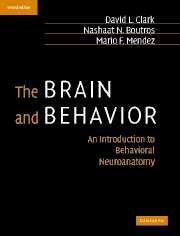Book contents
- Frontmatter
- Contents
- Preface
- 1 Introduction
- 2 Gross anatomy of the brain
- 3 Histology
- 4 Occipital and parietal lobes
- 5 Temporal lobe – neocortical structures
- 6 Frontal lobe
- 7 Basal ganglia
- 8 Diencephalon: hypothalamus and epithalamus
- 9 Diencephalon: thalamus
- 10 Brainstem
- 11 Limbic system: temporal lobe
- 12 Limbic system: cingulate cortex
- 13 Limbic system: overview
- 14 Interhemispheric connections and laterality
- Index
- Plate section
- References
1 - Introduction
Published online by Cambridge University Press: 25 August 2009
- Frontmatter
- Contents
- Preface
- 1 Introduction
- 2 Gross anatomy of the brain
- 3 Histology
- 4 Occipital and parietal lobes
- 5 Temporal lobe – neocortical structures
- 6 Frontal lobe
- 7 Basal ganglia
- 8 Diencephalon: hypothalamus and epithalamus
- 9 Diencephalon: thalamus
- 10 Brainstem
- 11 Limbic system: temporal lobe
- 12 Limbic system: cingulate cortex
- 13 Limbic system: overview
- 14 Interhemispheric connections and laterality
- Index
- Plate section
- References
Summary
Human behavior is a direct reflection of the anatomy and physiology of the central nervous system (CNS). The goal of the behavioral neuroscientist is to uncover the neuroanatomical substrates of behavior. Complex mental processes are represented in the brain by their elementary components. Elaborate mental functions consist of subfunctions and are constructed from both serial and parallel interconnections of several brain regions. An introduction to the nervous system covers general terminology and the ventricular system.
Major subdivisions
The nervous system is divided anatomically into the central nervous system (CNS) and the peripheral nervous system (PNS).
The CNS is made up of the brain and spinal cord.
The PNS consists of the cranial nerves and spinal nerves.
Physiologically, the nervous system can be divided into somatic and visceral (autonomic) divisions.
The somatic nervous system deals with the contraction of striated muscle and the sensations of the skin (pain, touch, temperature), the innervation of muscles and joint capsules (proprioception), and the reception of sensations remote to the body by way of special senses. The somatic nervous system senses and controls our interaction with the environment external to the body.
The autonomic nervous system controls the tone of the smooth muscles and the secretions of glands. It senses and controls the condition of the internal environment.
Common terms
The neuraxis is the long axis of the brain and spinal cord (Figure 1.1). A cross section (transverse section) is a section taken at right angles to the neuraxis.
Information
- Type
- Chapter
- Information
- The Brain and BehaviorAn Introduction to Behavioral Neuroanatomy, pp. 1 - 5Publisher: Cambridge University PressPrint publication year: 2005
